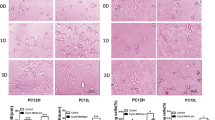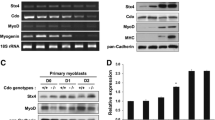Abstract
A transition of sialic acid (Sia) species on GM3 ganglioside from N-acetylneuraminic acid (Neu5Ac) to N-glycolylneuraminic acid (Neu5Gc) takes place in mouse C2C12 myoblast cells during their differentiation into myotube cells. However, the meaning of this Sia transition remains unclear. This study thus aims to gain a functional insight into this phenomenon. The following lines of evidence show that the increased de novo synthesis of Neu5Gc residues in differentiating myoblast cells promotes adhesiveness of the cells, which is beneficial for promotion of differentiation. First, the Sia transition occurred even in the C2C12 cells cultured in serum-free medium, indicating that it happens through de novo synthesis of Neu5Gc. Second, GM3(Neu5Gc) was localized in myoblast cells, but not in myotube cells, and related to expression of the CMP-Neu5Ac hydroxylase (CMAH) gene. Notably, expression of CMAH precedes myotube formation not only in differentiating C2C12 cells, but also in mouse developing embryos. Since the myoblast cells were attached on the dish surface more strongly than the myotube cells, expression of GM3(Neu5Gc) may be related to the surface attachment of the myoblast cells. Third, exogenous Neu5Gc, but not Neu5Ac, promoted differentiation of C2C12 cells, thus increasing the number of cells committed to fuse with each other. Fourth, the CMAH-transfected C2C12 cells were attached on the gelatin-coated surface much more rapidly than the mock-cells, suggesting that the expression of CMAH promotes cell adhesiveness through the expression of Neu5Gc.






Similar content being viewed by others
References
Chal, J., Pourquié, O.: Making muscle: skeletal myogenesis. Development 144(12), 2104–2122 (2017). https://doi.org/10.1242/dev.151035
Rudnicki, M.A., Schnegelsberg, P.N., Stead, R.H., Braun, T., Arnold, H.H., Jaenisch, R.: MyoD or Myf-5 is required for the formation of skeletal muscle. Cell 75(7), 1351–1359 (1993). https://doi.org/10.1016/0092-8674(93)90621-v
Hasty, P., Bradley, A., Morris, J.H., Edmondson, D.G., Venuti, J.M., Olson, E.N., et al.: Muscle deficiency and neonatal death in mice with a targeted mutation in the myogenin gene. Nature 364(6437), 501–506 (1993). https://doi.org/10.1038/364501a0
Millay, D.P., O’Rourke, J.R., Sutherland, L.B., Bezprozvannaya, S., Shelton, J.M., Bassel-Duby, R., et al.: Myomaker is a membrane activator of myoblast fusion and muscle formation. Nature 499(7458), 301–305 (2013). https://doi.org/10.1038/nature12343
Bi, P., Ramirez-Martinez, A., Li, H., Cannavino, J., McAnally, J.R., Shelton, J.M., et al.: Control of muscle formation by the fusogenic micropeptide myomixer. Science 356(6335), 323–327 (2017). https://doi.org/10.1126/science.aam9361
Barresi, R., Campbell, K.P.: Dystroglycan: from biosynthesis to pathogenesis of human disease. J Cell Sci. 119(Pt 2), 199–207 (2006). https://doi.org/10.1242/jcs.02814
Gerin, I., Ury, B., Breloy, I., Bouchet-Seraphin, C., Bolsée, J., Halbout, M., et al.: ISPD produces CDP-ribitol used by FKTN and FKRP to transfer ribitol phosphate onto α-dystroglycan. Nat Commun. 7, 11534 (2016). https://doi.org/10.1038/ncomms11534
Endo, T.: Glycobiology of α-dystroglycan and muscular dystrophy. J Biochem. 157(1), 1–12 (2015). https://doi.org/10.1093/jb/mvu066
Inamori, K., Yoshida-Moriguchi, T., Hara, Y., Anderson, M.E., Yu, L., Campbell, K.P.: Dystroglycan function requires xylosyl- and glucuronyltransferase activities of LARGE. Science 335(6064), 93–96 (2012). https://doi.org/10.1126/science.1214115
Huizing, M., Rakocevic, G., Sparks, S.E., Mamali, I., Shatunov, A., Goldfarb, L., et al.: Hypoglycosylation of alpha-dystroglycan in patients with hereditary IBM due to GNE mutations. Mol Genet Metab. 81(3), 196–202 (2004). https://doi.org/10.1016/j.ymgme.2003.11.012
Noguchi, S., Keira, Y., Murayama, K., Ogawa, M., Fujita, M., Kawahara, G., et al.: Reduction of UDP-N-acetylglucosamine 2-epimerase/N-acetylmannosamine kinase activity and sialylation in distal myopathy with rimmed vacuoles. J Biol Chem. 279(12), 11402–11407 (2004). https://doi.org/10.1074/jbc.M313171200
Tajima, Y., Uyama, E., Go, S., Sato, C., Tao, N., Kotani, M., et al.: Distal myopathy with rimmed vacuoles: impaired O-glycan formation in muscular glycoproteins. Am J Pathol. 166(4), 1121–1130 (2005). https://doi.org/10.1016/S0002-9440(10)62332-2
Go, S., Go, S., Veillon, L., Ciampa, M.G., Mauri, L., Sato, C., Kitajima, K., et al.: Altered expression of ganglioside GM3 molecular species and a potential regulatory role during myoblast differentiation. J Biol Chem. 292(17), 7040–7051 (2017). https://doi.org/10.1074/jbc.M116.771253
Go, S., Sato, C., Furuhata, K., Kitajima, K.: Oral ingestion of mannose alters the expression level of deaminoneuraminic acid (KDN) in mouse organs. Glycoconj J. 23(5–6), 411–421 (2006). https://doi.org/10.1007/s10719-006-6734-z
Schauer, R., Kamerling, J.P.: Exploration of the Sialic Acid World. Adv Carbohydr Chem Biochem. 75, 1–213 (2018). https://doi.org/10.1016/bs.accb.2018.09.001
Kitajima, K., Varki, N., Sato, C.: Advanced Technologies in Sialic Acid and Sialoglycoconjugate Analysis. Top Curr Chem. 367, 75–103 (2015). https://doi.org/10.1007/128_2013_458
Sato, C., Kitajima, K.: Sialic Acids in Neurology. Adv Carbohydr Chem Biochem. 76, 1–64 (2019). https://doi.org/10.1016/bs.accb.2018.09.003
Varki, N.M., Varki, A.: Diversity in cell surface sialic acid presentations: implications for biology and disease. Lab Invest. 87(9), 851–857 (2007). https://doi.org/10.1038/labinvest.3700656
Kawano T, Koyama S, Takematsu H, Kozutsumi Y, Kawasaki H, Kawashima S, et al. Molecular cloning of cytidine monophospho-N-acetylneuraminic acid hydroxylase. Regulation of species- and tissue-specific expression of N-glycolylneuraminic acid. J Biol Chem. 270(27):16458–63 (1995). https://doi.org/10.1074/jbc.270.27.16458
Kawano T, Kozutsumi Y, Kawasaki T, Suzuki A. Biosynthesis of N-glycolylneuraminic acid-containing glycoconjugates. Purification and characterization of the key enzyme of the cytidine monophospho-N-acetylneuraminic acid hydroxylation system. J Biol Chem. 269(12), 9024–9 (1994)
Ozawa, H., Kawashima, I., Tai, T.: Generation of murine monoclonal antibodies specific for N-glycolylneuraminic acid-containing gangliosides. Arch Biochem Biophys. 294(2), 427–433 (1992). https://doi.org/10.1016/0003-9861(92)90707-4
Laemmli, U.K.: Cleavage of structural proteins during the assembly of the head of bacteriophage T4. Nature 227(5259), 680–685 (1970). https://doi.org/10.1038/227680a0
Sato, C., Inoue, S., Matsuda, T., Kitajima, K.: Fluorescent-assisted detection of oligosialyl units in glycoconjugates. Anal Biochem. 266, 102–109 (1999). https://doi.org/10.1006/abio.1998.2921
Nakanishi, K., Dohmae, N., Morishima, N.: Endoplasmic reticulum stress increases myofiber formation in vitro. FASEB J. 21(11), 2994–3003 (2007). https://doi.org/10.1096/fj.06-6408com
Furukawa, K., Yamaguchi, H., Oettgen, H.F., Old, L.J., Lloyd, K.O.: Analysis of the expression of N-glycolylneuraminic acid-containing gangliosides in cells and tissues using two human monoclonal antibodies. J Biol Chem 263, 18507–18512 (1988)
Bardor, M., Nguyen, D.H., Diaz, S., Varki, A.: Mechanism of uptake and incorporation of the non–human sialic acid N-glycolylneuraminic acid into human cells. J Biol Chem 280, 4228–4237 (2005). https://doi.org/10.1074/jbc.M412040200
Yin, J., Hashimoto, A., Izawa, M., Miyazaki, K., Chen, G.-Y., Takematsu, H., Kozutsumi, Y., Suzuki, A., Furuhata, K., Cheng, F.-L., Lin, C.-H., Sato, C., Kitajima, K., Kannagi, R.: Hypoxic culture induces expression of sialin, a sialic acid transporter, and cancer-associated gangliosides containing non–human sialic acid on human cancer cells. Cancer Res 66(6), 2937–2945 (2006). https://doi.org/10.1158/0008-5472.CAN-05-2615
Giordani, L., Parisi, A., Le Grand, F.: Satellite Cell Self-Renewal. Curr Top Dev Biol. 126, 177–203 (2018). https://doi.org/10.1016/bs.ctdb.2017.08.001
Kuang, S., Gillespie, M.A., Rudnicki, M.A.: Niche regulation of muscle satellite cell self-renewal and differentiation. Cell Stem Cell 2(1), 22–31 (2008). https://doi.org/10.1016/j.stem.2007.12.012
Ng, P.S., Böhm, R., Hartley-Tassell, L.E., Steen, J.A., Wang, H., Lukowski, S.W., et al.: Ferrets exclusively synthesize Neu5Ac and express naturally humanized influenza A virus receptors. Nat Commun. 5, 5750 (2014). https://doi.org/10.1038/ncomms6750
Bergfeld AK, Varki A. Cytidine monophospho-N-acetylneuraminic acid hydroxylase (CMAH). Handbook of Glycosyltransferases and Related Genes 1559–80 (2014)
Cariappa, A., Takematsu, H., Liu, H., Diaz, S., Haider, K., Boboila, C., et al.: B cell antigen receptor signal strength and peripheral B cell development are regulated by a 9-O-acetyl sialic acid esterase. J Exp Med. 206(1), 125–138 (2009). https://doi.org/10.1084/jem.20081399
Martin, P.T., Camboni, M., Xu, R., Golden, B., Chandrasekharan, K., Wang, C.M., et al.: N-Glycolylneuraminic acid deficiency worsens cardiac and skeletal muscle pathophysiology in α-sarcoglycan-deficient mice. Glycobiology 23(7), 833–843 (2013). https://doi.org/10.1093/glycob/cwt020
Martin, P.T., Golden, B., Okerblom, J., Camboni, M., Chandrasekharan, K., Xu, R., et al.: A comparative study of N-glycolylneuraminic acid (Neu5Gc) and cytotoxic T cell (CT) carbohydrate expression in normal and dystrophin-deficient dog and human skeletal muscle. PLoS ONE 9(2), e88226 (2014). https://doi.org/10.1371/journal.pone.0088226
Acknowledgements
I (KK) am personally grateful to Dr. Sen-itiro Hakomori for his direct and indirect encouragements on me especially early in my career. I still remember my feeling when I happened to encounter his paper (Eggens et al. J. Biol. Chem. 1989; 264:9476-84) in the airplane from Japan to the US for attending an international meeting. It was as if I was struck by lightning. This was an early stage-study of the carbohydrate-carbohydrate interaction in the biological context, and actually overturned the existing concept of biomolecules. Since that time, I have been inspired by his way of thinking in science from time to time. No doubt that his contributions to glycobiology, particularly glycosphingolipid biology, would never been forgotten forever.
We thank Dr. Jin-ichi Inokuchi for his encouragement to this study. This work was supported by the Nagoya University operational subsidies 2019-2020 (to KK), Grants-in-Aid for JSPS Fellow 17J05805 (to SoG) and for Scientific Research (C) 18K06120 (to SnG).
Author information
Authors and Affiliations
Contributions
K.K. designed the study, analyzed the data, and prepared the main manuscript text and figures. So.G. was involved in all the experimental design and performances, and prepared the main manuscript text and all the figures. M.H. was involved in the design of construction of plasmids and management of the animal experiments; Sn.G. designed the study and analyzed the data. S.C. designed the study and analyzed the data.
Corresponding author
Ethics declarations
Ethical Statement
Not applicable.
Conflicts of interest/Competing interests
(include appropriate disclosures).
Not applicable.
Additional information
Publisher's Note
Springer Nature remains neutral with regard to jurisdictional claims in published maps and institutional affiliations.
Rights and permissions
About this article
Cite this article
Go, S., Sato, C., Hane, M. et al. Implication of N-glycolylneuraminic acid in regulation of cell adhesiveness of C2C12 myoblast cells during differentiation into myotube cells. Glycoconj J 39, 619–631 (2022). https://doi.org/10.1007/s10719-022-10049-9
Received:
Revised:
Accepted:
Published:
Issue Date:
DOI: https://doi.org/10.1007/s10719-022-10049-9




